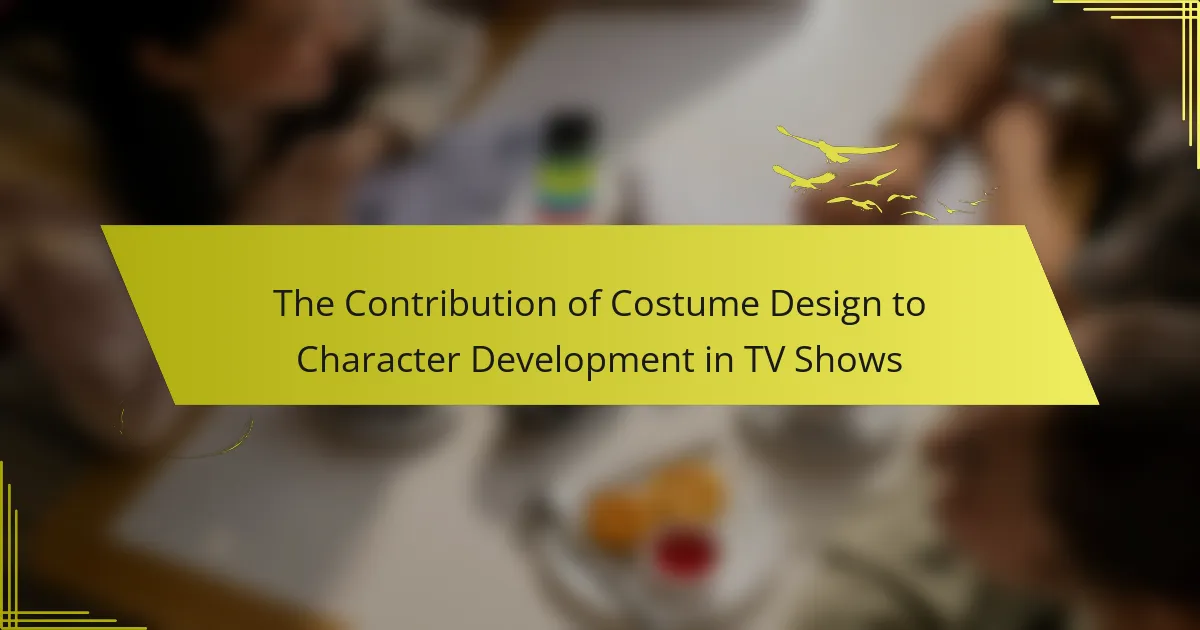Costume design is a critical component of character development in TV shows, serving to visually express a character’s personality, background, and evolution. The choices in clothing can convey social status, profession, and emotional states, enhancing storytelling and audience engagement. Effective costume design incorporates authenticity, character alignment, visual storytelling, and cultural relevance, ensuring that costumes accurately reflect the narrative context and character arcs. Collaboration between costume designers and other production departments, such as directors and makeup artists, further enriches character portrayal, leading to a more immersive viewing experience. Overall, this article explores how costume design contributes significantly to character development and viewer perception in television narratives.

What is the role of costume design in character development in TV shows?
Costume design plays a crucial role in character development in TV shows. It visually communicates a character’s personality, background, and evolution. Specific clothing choices can signify a character’s social status, profession, or emotional state. For example, a character in a tailored suit may be perceived as authoritative, while casual attire can suggest a laid-back attitude. Costume design also aids in storytelling by reflecting changes in a character’s journey. As characters undergo transformations, their costumes often evolve to mirror these shifts. This visual representation reinforces the narrative and deepens audience engagement. Research indicates that viewers often make judgments about characters based on their attire, highlighting the significance of costume design in shaping perceptions and character arcs.
How does costume design influence audience perception of characters?
Costume design significantly influences audience perception of characters by visually conveying personality traits and social status. Costumes can indicate a character’s role, such as hero or villain, through color, style, and fabric choice. For example, bright colors often signify positivity, while dark colors may suggest malevolence. Historical accuracy in costumes can enhance authenticity, affecting how audience members relate to characters. Research indicates that viewers often make snap judgments based on costumes, impacting their emotional engagement. Studies show that characters in well-designed costumes are perceived as more credible and memorable. This visual storytelling element shapes the audience’s understanding and emotional connection to the character.
What elements of costume design contribute to character identity?
Costume design elements significantly contribute to character identity. Key elements include color, texture, silhouette, and accessories. Color can evoke specific emotions and associations. For example, red often symbolizes passion or danger. Texture influences the perception of a character’s social status or personality traits. Silhouettes help establish a character’s role or archetype in the narrative. Accessories can provide unique details that highlight a character’s interests or background. Historical context also plays a role in costume design, ensuring authenticity and relatability. Overall, these elements work together to create a visual representation of a character’s identity and development within the story.
How do colors and textures in costumes reflect character traits?
Colors and textures in costumes significantly reflect character traits. Bright colors often signify optimism or energy, while darker shades can indicate mystery or villainy. Textures such as rough fabrics may suggest a rugged personality, whereas smooth materials can imply sophistication. For example, a character in vibrant, flowing garments may be portrayed as free-spirited. In contrast, a character in muted, rigid attire might be depicted as serious or authoritarian. Historical context supports these associations, as color psychology shows that red can evoke passion, while blue often represents calmness. Costume designers strategically use these elements to enhance storytelling and character development in TV shows.
Why is costume design considered a vital storytelling tool?
Costume design is considered a vital storytelling tool because it visually conveys character traits and emotions. Costumes help establish a character’s identity, background, and social status. For instance, a character in tattered clothing may suggest poverty or struggle. Conversely, luxurious attire can imply wealth or power.
Additionally, costume design can indicate changes in a character’s arc. A transformation in wardrobe often reflects personal growth or decline. This visual cue enhances audience understanding without the need for dialogue. Historical accuracy in costume also grounds the narrative in a specific time and place.
Research shows that costumes can influence audience perception significantly. A study by the University of Southern California found that viewers form immediate judgments about characters based on their costumes. Thus, effective costume design enriches storytelling by providing essential context and depth to characters.
How does costume design enhance narrative themes in TV shows?
Costume design enhances narrative themes in TV shows by visually representing characters’ identities and arcs. It conveys emotions and social status through color, fabric, and style choices. For instance, a character’s transformation can be illustrated through changes in their attire. Historical accuracy in costumes can ground the narrative in a specific time period, enhancing authenticity. Symbolic elements in costume can reflect underlying themes, such as power or rebellion. Research shows that audiences often interpret character motivations and relationships through their clothing. This visual storytelling deepens viewer engagement and understanding of the plot. Overall, effective costume design is crucial for reinforcing narrative themes in television.
What are some examples of effective costume design that supports character arcs?
Effective costume design significantly enhances character arcs in various TV shows. In “Breaking Bad,” Walter White’s transformation from a meek teacher to a drug kingpin is mirrored by his evolving wardrobe. Initially, he wears simple, unassuming clothes. As he gains power, his attire becomes darker and more sophisticated, reflecting his moral decline.
In “The Crown,” Queen Elizabeth II’s costumes evolve to signify her growth and the changing times. Early in the series, her outfits are conservative, symbolizing her traditional role. As she faces challenges, her clothing becomes more modern, representing her adaptability and strength.
In “Game of Thrones,” Daenerys Targaryen’s costumes reflect her journey from a vulnerable sister to a powerful leader. Her early outfits are modest, while her later attire incorporates regal elements and dragon motifs, showcasing her claim to power.
These examples demonstrate how costume design effectively supports character arcs by visually representing their development and transformations throughout the narratives.

What are the key attributes of effective costume design in TV shows?
Effective costume design in TV shows includes authenticity, character alignment, visual storytelling, and cultural relevance. Authenticity ensures costumes reflect the time period and setting accurately. Character alignment means costumes represent the personality and evolution of characters. Visual storytelling conveys emotions and themes through color, texture, and style choices. Cultural relevance connects costumes to societal norms and values, enhancing relatability. Each attribute plays a vital role in enhancing character development and audience engagement.
How do cultural and historical contexts affect costume design choices?
Cultural and historical contexts significantly influence costume design choices. Designers draw inspiration from the traditions, values, and aesthetics of specific cultures. For example, a show set in the Victorian era will feature clothing that reflects the social norms and materials of that time. Historical accuracy enhances the authenticity of character portrayal. Additionally, cultural elements can signify a character’s background or social status. Costumes may incorporate traditional patterns, colors, or styles that resonate with particular communities. This use of cultural symbols helps viewers connect with characters on a deeper level. Overall, costume design serves as a visual narrative shaped by the cultural and historical backdrop of the story.
What research do costume designers undertake to ensure authenticity?
Costume designers undertake extensive research to ensure authenticity in their designs. They study historical references to accurately represent the time period. This includes examining clothing styles, fabrics, and colors used in specific eras. Designers often consult primary sources like paintings, photographs, and fashion magazines. They also analyze scripts for character backgrounds and settings. Collaborating with historians and experts enhances their understanding of cultural contexts. Additionally, designers may visit museums to view original garments. This thorough research process helps create believable and immersive characters in TV shows.
How do costume designers balance creativity with practicality in their designs?
Costume designers balance creativity with practicality by integrating artistic vision with functional requirements. They create designs that reflect character traits while ensuring comfort and mobility for actors. Designers often collaborate with directors and producers to align on the vision. They consider the production’s budget and timeline during the design process. Materials chosen must be both visually appealing and durable. Historical accuracy may also influence design choices, especially in period pieces. Ultimately, successful costume design enhances storytelling without compromising the actor’s performance.
What techniques do costume designers use to convey character evolution?
Costume designers use various techniques to convey character evolution. They utilize color palettes to reflect a character’s emotional state. For example, brighter colors may indicate happiness or growth, while darker shades can signify despair or conflict. Additionally, costume designers alter clothing styles to represent changes in status or personality. A character’s transition from casual to formal attire can indicate a shift in their role or confidence. Fabric choices also play a significant role; luxurious materials may suggest wealth or success, while worn fabrics can hint at struggle or decline. Accessories are strategically added or removed to mark pivotal moments in a character’s journey. For instance, the introduction of a significant piece of jewelry can symbolize a new relationship or commitment. Overall, these techniques help audiences visually track character development throughout a narrative.
How do changes in costume reflect character growth throughout a series?
Changes in costume reflect character growth throughout a series by visually representing internal transformations. Costumes can signify shifts in personality, status, or emotional state. For example, a character may start with simple attire and gradually adopt more complex outfits as they gain confidence. This evolution often aligns with key plot developments. Costume changes can also indicate a character’s moral alignment, such as moving from dark colors to lighter tones symbolizing redemption. In many series, these visual cues help the audience understand character arcs without explicit dialogue. The use of costume design as a storytelling tool is well-documented in studies of visual narrative.
What role does costume design play in foreshadowing character developments?
Costume design plays a crucial role in foreshadowing character developments. It visually represents a character’s journey and transformation. For instance, a character’s attire may shift from drab to vibrant colors as they gain confidence. This change often hints at their evolving personality or upcoming challenges. Historical examples include characters in period dramas whose costumes reflect their social status or internal conflicts. Costume choices can also signal alliances or betrayals, enhancing narrative depth. Thus, effective costume design subtly prepares the audience for significant character arcs.

How do collaborations between costume designers and other departments affect character portrayal?
Collaborations between costume designers and other departments significantly enhance character portrayal. Costume designers work closely with directors, writers, and actors to align visual elements with narrative intent. This collaboration ensures that costumes reflect the character’s personality, background, and emotional state. For instance, a character’s costume may indicate their social status or development throughout the story. Additionally, input from makeup and hair departments further refines the character’s overall look. Research shows that cohesive teamwork in production leads to more authentic character representation. This synergy ultimately contributes to a richer viewing experience for the audience.
What is the relationship between costume design and production design?
Costume design and production design are closely interconnected elements of visual storytelling. Costume design focuses on creating clothing that reflects a character’s personality and context. Production design encompasses the overall aesthetic of the set, including backgrounds and props. Both work together to establish the tone and atmosphere of a production. For instance, a character’s costume can enhance the visual narrative set by the production design. This synergy helps convey themes and emotions effectively. In film and television, cohesive design elements contribute to audience immersion. Therefore, the relationship is essential for creating a believable and engaging world.
How does costume design interact with lighting and cinematography to enhance character presence?
Costume design interacts with lighting and cinematography to enhance character presence by creating visual coherence and emotional resonance. Costumes establish a character’s identity and can be accentuated by specific lighting techniques. For instance, high-key lighting can highlight vibrant colors in costumes, making characters appear more lively. Conversely, low-key lighting can create shadows that add depth and intrigue to a character’s outfit.
Cinematography captures these elements, framing characters in ways that emphasize their costumes. Close-ups can draw attention to intricate details in the fabric or accessories. Additionally, color grading in post-production can alter the perceived mood of a scene, affecting how costumes are interpreted.
Research indicates that the interplay of these elements can significantly impact audience perception. A study by the American Society of Cinematographers found that effective costume design combined with strategic lighting enhances viewer engagement and emotional connection to characters.
What are the common challenges faced by costume designers in character development?
Costume designers face several common challenges in character development. One significant challenge is aligning costumes with the character’s personality and backstory. Designers must interpret scripts and character arcs accurately. Budget constraints often limit fabric choices and design options. Time constraints can lead to rushed designs, affecting quality. Collaboration with directors and actors is crucial but can be complicated. Designers must also consider historical accuracy for period pieces. Balancing creativity with practicality is essential for functionality in costumes. Lastly, audience perception can influence design decisions, requiring careful consideration of visual impact.
How do budget constraints impact costume design choices?
Budget constraints significantly limit costume design choices. Designers often face restrictions on materials and labor costs. This can lead to simplified designs or the use of less expensive fabrics. Costume choices may prioritize essential elements over intricate details. Limited budgets can also restrict the number of costumes available for each character. Consequently, designers might focus on creating versatile pieces that can be adapted for various scenes. Historical accuracy may be sacrificed for practicality when budgets are tight. In some cases, designers rely on existing wardrobe pieces to save costs. Overall, budget constraints directly influence the quality and variety of costumes in a production.
What strategies can costume designers use to overcome design limitations?
Costume designers can use several strategies to overcome design limitations. They can prioritize flexibility in materials to allow for movement and adaptability. Utilizing digital design tools can help visualize costumes before physical creation. Collaboration with directors and actors can provide insights that enhance design choices. Budget management is crucial; designers can source materials creatively to stay within limits. Researching historical and cultural contexts can inspire authentic designs. Simplifying complex designs can also maintain visual impact while reducing production challenges. Lastly, adapting designs based on feedback during fittings can lead to more practical outcomes.
What are best practices for integrating costume design into character development?
Best practices for integrating costume design into character development include aligning costumes with character traits. Costumes should reflect the personality, background, and evolution of characters. This alignment helps audiences understand characters better. Collaborating with writers and directors ensures cohesive storytelling. Research shows that visual elements significantly impact audience perception. For example, studies indicate that costumes can influence character relatability and empathy. Additionally, considering historical and cultural contexts enhances authenticity. Using color psychology can also convey emotions and traits effectively. Engaging actors in the costume design process fosters authenticity in performance.
How can costume designers collaborate effectively with directors and writers?
Costume designers can collaborate effectively with directors and writers by maintaining open communication throughout the production process. Regular meetings allow costume designers to understand the vision and narrative intent of the director and writers. Sharing research and mood boards helps align everyone’s creative vision. Costume designers should present sketches and fabric samples for feedback, ensuring designs reflect character arcs. Incorporating notes from directors and writers into costume choices enhances character development. Understanding the story’s themes and character motivations is crucial for costume designers. This collaborative approach has been shown to result in more cohesive and impactful visual storytelling.
What resources are available for aspiring costume designers to improve their craft?
Aspiring costume designers can access various resources to enhance their skills. Books on costume design provide foundational knowledge and techniques. Online courses from platforms like Coursera and Skillshare offer structured learning. Workshops conducted by industry professionals allow hands-on experience. Networking events and conferences facilitate connections with experienced designers. Social media groups and forums provide community support and feedback. Additionally, internships with theater companies or film productions offer practical experience. Each of these resources contributes to skill development in costume design.
The main entity of this article is costume design in TV shows, specifically its role in character development. The article examines how costume design visually communicates character traits, influences audience perception, and enhances narrative themes. It discusses key elements such as color, texture, and historical accuracy, as well as the collaborative process between costume designers and other departments. Additionally, the article highlights challenges faced by designers, strategies to overcome limitations, and best practices for integrating costume design into character development, providing a comprehensive overview of its significance in storytelling.




